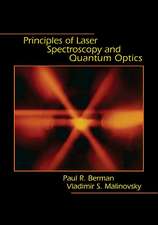The Structure and Properties of Matter: Springer Series in Solid-State Sciences, cartea 28
Editat de T. Matsubara Traducere de Takeo Matsubara Contribuţii de H. Matsuda, T. Murao, T. Tsuneto, F. Yonezawaen Limba Engleză Paperback – 15 dec 2011
Din seria Springer Series in Solid-State Sciences
- 18%
 Preț: 1225.94 lei
Preț: 1225.94 lei - 18%
 Preț: 1017.62 lei
Preț: 1017.62 lei - 15%
 Preț: 532.05 lei
Preț: 532.05 lei - 18%
 Preț: 944.51 lei
Preț: 944.51 lei -
 Preț: 541.47 lei
Preț: 541.47 lei - 18%
 Preț: 956.96 lei
Preț: 956.96 lei -
 Preț: 385.84 lei
Preț: 385.84 lei - 18%
 Preț: 1827.48 lei
Preț: 1827.48 lei - 15%
 Preț: 661.02 lei
Preț: 661.02 lei -
 Preț: 389.88 lei
Preț: 389.88 lei - 15%
 Preț: 639.59 lei
Preț: 639.59 lei - 15%
 Preț: 635.15 lei
Preț: 635.15 lei - 18%
 Preț: 896.21 lei
Preț: 896.21 lei - 15%
 Preț: 647.92 lei
Preț: 647.92 lei - 15%
 Preț: 651.34 lei
Preț: 651.34 lei - 18%
 Preț: 890.23 lei
Preț: 890.23 lei - 15%
 Preț: 640.55 lei
Preț: 640.55 lei - 15%
 Preț: 649.54 lei
Preț: 649.54 lei - 15%
 Preț: 645.60 lei
Preț: 645.60 lei - 15%
 Preț: 644.30 lei
Preț: 644.30 lei - 15%
 Preț: 653.79 lei
Preț: 653.79 lei - 18%
 Preț: 956.69 lei
Preț: 956.69 lei - 15%
 Preț: 637.59 lei
Preț: 637.59 lei - 23%
 Preț: 1043.42 lei
Preț: 1043.42 lei - 15%
 Preț: 639.08 lei
Preț: 639.08 lei - 15%
 Preț: 648.24 lei
Preț: 648.24 lei - 15%
 Preț: 637.46 lei
Preț: 637.46 lei - 15%
 Preț: 640.06 lei
Preț: 640.06 lei -
 Preț: 391.40 lei
Preț: 391.40 lei -
 Preț: 390.84 lei
Preț: 390.84 lei - 15%
 Preț: 638.57 lei
Preț: 638.57 lei - 18%
 Preț: 1006.06 lei
Preț: 1006.06 lei - 18%
 Preț: 730.79 lei
Preț: 730.79 lei - 15%
 Preț: 640.37 lei
Preț: 640.37 lei - 15%
 Preț: 643.65 lei
Preț: 643.65 lei - 18%
 Preț: 1231.01 lei
Preț: 1231.01 lei - 18%
 Preț: 950.21 lei
Preț: 950.21 lei - 15%
 Preț: 642.68 lei
Preț: 642.68 lei - 15%
 Preț: 640.55 lei
Preț: 640.55 lei - 18%
 Preț: 1229.10 lei
Preț: 1229.10 lei
Preț: 397.76 lei
Nou
Puncte Express: 597
Preț estimativ în valută:
76.11€ • 81.39$ • 63.46£
76.11€ • 81.39$ • 63.46£
Carte tipărită la comandă
Livrare economică 18 aprilie-02 mai
Preluare comenzi: 021 569.72.76
Specificații
ISBN-13: 9783642817311
ISBN-10: 3642817319
Pagini: 464
Ilustrații: XII, 452 p.
Dimensiuni: 155 x 235 x 24 mm
Greutate: 0.64 kg
Ediția:1982
Editura: Springer Berlin, Heidelberg
Colecția Springer
Seria Springer Series in Solid-State Sciences
Locul publicării:Berlin, Heidelberg, Germany
ISBN-10: 3642817319
Pagini: 464
Ilustrații: XII, 452 p.
Dimensiuni: 155 x 235 x 24 mm
Greutate: 0.64 kg
Ediția:1982
Editura: Springer Berlin, Heidelberg
Colecția Springer
Seria Springer Series in Solid-State Sciences
Locul publicării:Berlin, Heidelberg, Germany
Public țintă
ResearchCuprins
1. Atoms as Constituents of Matter.- 1.1 Introduction.- 1.2 Atomic Scale.- 1.3 One-Electron Atoms and the Hydrogen Atom.- 1.4 Central-Field Approximation.- 1.5 Shell Structure of Atoms and Periodicity of the Elements.- 1.6 Stationary States of Atoms I.- 1.7 Stationary States of Atoms II.- 2. System of Protons and Electrons.- 2.1 General Comments.- 2.2 Electronic State of a Hydrogen Molecule.- 2.3 Systems Made of Hydrogen Molecules.- 2.4 Metallic State at High Density.- 2.5 Phase Diagram of the Proton-Electron System.- 3. Helium.- 3.1 Characteristics of Helium.- 3.2 Superfluidity.- 3.3 Phonons and Rotons.- 3.4 Liquid 3He; Fermi Liquid.- 4. Super fluid Helium 3.- 4.1 Basic Properties.- 4.2 Spin Triplet P-Wave Pairing.- 4.3 Physical Properties of ABM and BW States.- 4.4 Fermi Liquid Effects.- 4.5 Nuclear Spin Dynamics.- 4.6 Texture and Superfluidity.- 5. Metals.- 5.1 Characteristics of Metals.- 5.2 Band Theory of Metals.- 5.3 Fermi Surface.- 5.4 Pseudopotential of Simple Metals.- 5.5 Structure of Simple Metals,.- 5.6 Transition Metals.- 5.7 Alloys.- 5.8 Superconductivity.- 6. Nonmetals.- 6.1 Molecular Crystals.- 6.2 Ionic Crystals.- 6.3 Covalent Crystal.- 6.4 Hydrogen-Bonded Crystals.- 6.5 Electron Theory of Nonmetals (Semiconductors).- 6.6 Semimetals.- 6.7 Properties of Matter Under High Pressure.- 7. Localized Electron Approximation.- 7.1 A Simple Model for Tetrahedrally Bonded Semiconductors.- 7.2 Bond Orbital Model (BOM).- 7.3 Cohesive Energy and Stability of Crystal Structures.- 7.4 Relationship Between the BOM and EPM.- 8. Magnetism.- 8.1 Magnetic Properties of Solids.- 8.2 Magnetic Properties of Simple Solids.- 8.3 Mechanism of Spin Polarization and the Electronic State in Solids.- 8.4 Configurations of Spin Polarization in Magnetic-Ordered States.- 8.5 Collective Motion in Ordered States and Phase Transitions.- 8.6 Magnetic Properties of Dilute Alloys.- 8.7 Applications of Magnetic Measurements for Condensed Matter.- 9. Magnetic Properties of Dilute Alloys — the Kondo Effect.- 9.1 Recent Investigations of the Kondo Effect.- 9.2 A Survey of Recent Experiments.- 9.3 Yosida-Yamada Theory.- 9.4 Renormalization Group Approach.- 10. Random Systems.- 10.1 Periodic and Aperiodic Systems.- 10.2 Point Defects.- 10.3 Line Imperfections and Dislocations.- 10.4 Cradle of Random Systems — Melting of Crystals and Order-Disorder Phase Transition in Alloys.- 10.5 Noncrystalline Solids.- 10.6 Liquid Metals and Electronic and Vibrational States of Random Systems.- 11. Coherent Potential Approximation (CPA).- 11.1 Survey.- 11.2 A Few Examples of Experimental Results.- 11.3 Computer Simulations and Exact Solutions.- 11.4 Model Hamiltonian.- 11.5 One-Particle Green’s Function.- 11.6 Approximations before CPA.- 11.7 Derivation and the Characteristic Features of the CPA.- 11.8 Applications of the CPA.- 11.9 Universality of the CPA.- References.

















